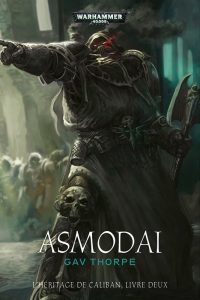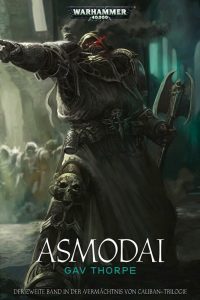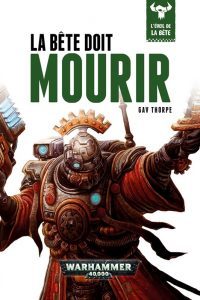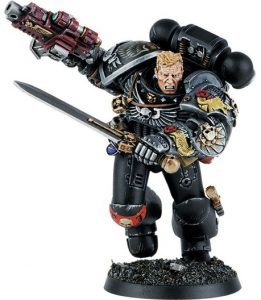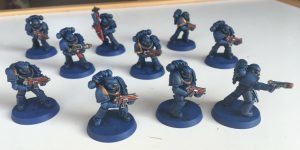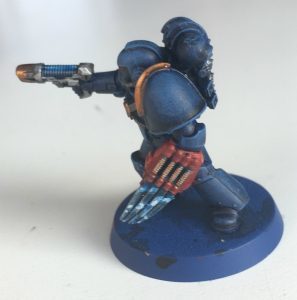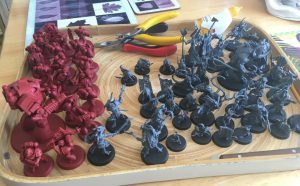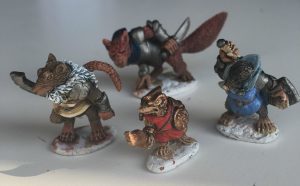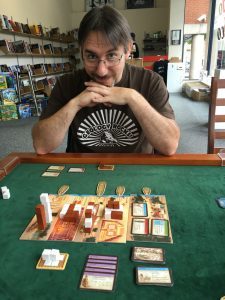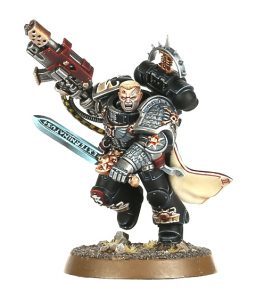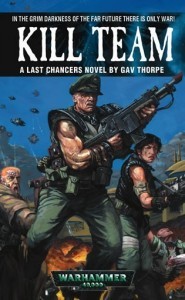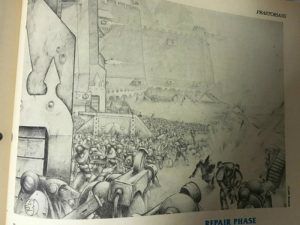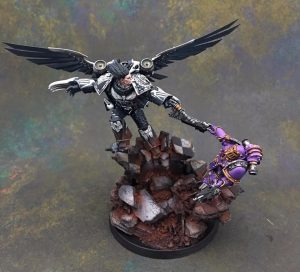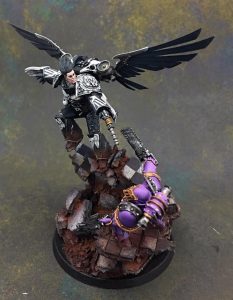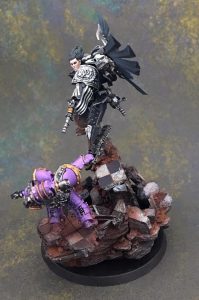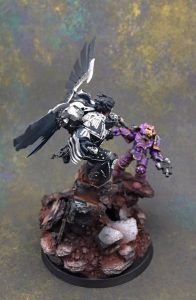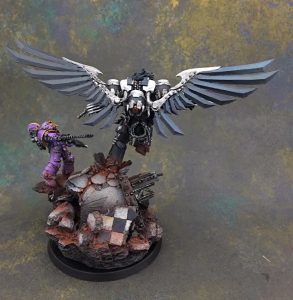Gav Thorpe's Blog, page 13
November 6, 2016
Asmodai French & German Translations
The French and German translations of Master of Sanctity are available today in paperback from Black Library.
Title: Asmodai
ISBN: 978-1780303246
Format: Livre de poche
Purchase from: Black Library
“L’Héritage de Caliban résonne à travers les âges, et la mission secrète dont les Dark Angels sont investis continue. Où qu’il tourne son regard, le Chaplain Asmodai ne trouve que traîtrise et tromperie. Et si son instinct lui est fort utile dans sa quête des Déchus, il rend difficiles les relations entre son chapitre et le reste de ses alliés impériaux. Alors que leur véritable but semble enfin être à leur portée, les Frères Annael et Telemus se retrouvent en première ligne d’une nouvelle opération dont les ramifications pourraient bien secouer l’Imperium jusqu’en ses tréfonds…”
Title: Asmodai
ISBN: 978-1781931523
Format: Tauschenbuchausgabe
Purchase from: Black Library
“Das Vermächtnis von Caliban hallt durch die Zeitalter, und die geheime Mission der Dark Angels geht weiter. Interrogator-Chaplain Asmodai sieht allenorts Verrat und Täuschung – dies leistet ihm gute Dienste bei der Jagd auf die Gefallenen, doch es belastet die Beziehungen des Ordens zu seinen imperialen Verbündeten. Nun, da ihre Beute in Reichweite zu sein scheint, stehen die Brüder Annael und Telemenus an vorderster Front eines Einsatzes, der das Imperium in seinen Grundfesten erschüttern könnte.”
**To make sure you don’t miss out on any blog posts, you can keep up-to-date with everything Gav by signing up to my monthly newsletter. As a bonus, every other month I randomly pick a newsletter subscriber to receive a free signed copy of one of my books.**
Please Feel Free to Share:







November 5, 2016
Die Bestie Muss Sterben & La Bete Doit Mourir
The French and German translations of The Beast Must Die are available today in Hardback from Black Library.
Title: La Bete Doit Mourir
ISBN: 978-1780302898
Format: Relié
Purchase from: Black Library
“Une invasion ork d’une envergure sans précédent à conduit l’Imperium au bord de l’extinction. Les attaques isolées de l’humanité se sont révélées inefficaces, et pour chaque flotte ork détruite, cinq de plus apparaissent. La seule solution restante pour l’humanité est de trouver et de détruire la Bête: après tout, sans la tête, le corps ne peut pas survivre, et l’empire ork s’écroulera comme un château de cartes. Koorland rassemble une gigantesque armée dans le but de mettre fin à l’invasion une bonne fois pour toutes, mais les forces de l’Imperium se rendront bientôt compte à quel point elles ont sous-estimé la puissance et la ruse de leur ennemi.”
Title: Die Bestie Muss Sterben
ISBN: 978-1781931783
Format: Relié
Purchase from: Black Library
“Eine Invasion der Orks von ungekannten Ausmaßen hat das Imperium an den Rand der Vernichtung geführt. Die unkoordinierten Angriffe haben keine Wirkung gegen die Invasoren gezeigt – für jede vernichtete Ork-Flotte tauchen fünf neue auf. Die einzige Lösung besteht darin, den Anführer der Orks – die Große Bestie – zu finden und zu töten, um das Reich der Grünhäute durch interne Machtkämpfe um die Nachfolge zu destabilisieren. Koorland stellt eine mächtige Armee auf, aber als sie die Heimatwelt der Orks erreichen, müssen die Streitkräfte des Imperiums feststellen, dass sie die Macht und Raffinesse ihres Feindes unterschätzt haben.”
**To make sure you don’t miss out on any blog posts, you can keep up-to-date with everything Gav by signing up to my monthly newsletter. As a bonus, every other month I randomly pick a newsletter subscriber to receive a free signed copy of one of my books.**
Please Feel Free to Share:







November 2, 2016
Game Review – La Granja
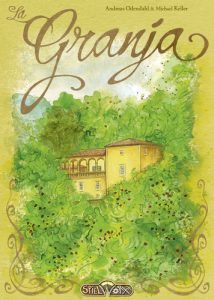 Whenever I post a Facebook status about a new game I’ve played, I get people asking for more information about it, and whether it’s worth buying. The answer to the second question is clearly “yes” because you can never have too many games. A blog is better than Facebook for lengthier posts, so I thought I’d start doing a few game reviews when I have the time. These will no doubt be sporadic as it’s likely that if I have time to review a game I might be using it to play instead! We’ll see how we get on.
Whenever I post a Facebook status about a new game I’ve played, I get people asking for more information about it, and whether it’s worth buying. The answer to the second question is clearly “yes” because you can never have too many games. A blog is better than Facebook for lengthier posts, so I thought I’d start doing a few game reviews when I have the time. These will no doubt be sporadic as it’s likely that if I have time to review a game I might be using it to play instead! We’ll see how we get on.
Kez and I took advantage of Auntie babysitter last week and went to the Dice Cup in Nottingham for the afternoon and evening. With several hours ahead of us, we chose a 90 minute game, so we could play it through 2-3 times to really familiarise ourselves. To this end, Kez decided on La Granja.
“In La Granja, players control small farms by the Alpich pond near the village of Esporles on the island of Mallorca. Over time, the players develop their farms and deliver goods to the village. Players are vying to earn the title of “La Granja” for their country estate!
Over the course of 6 game rounds, players will expand their farm by adding fields, farm extensions, market barrows, and helpers. They will earn VPs by delivering goods to the village of Esporles. It is important to observe the actions of other players, manipulate turn order, and adjust your strategy based on the dice and cards.
La Granja is a fascinating game that requires careful planning. Timing and speed is crucial. However, successful players must cope with the uncertainty of events during the game. The player who has earned the most victory points at the end of the game is the winner and new owner of the La Granja estate!”
Four and a half hours later we just about finished the first game before stomachs were rumbling and dinner had to be eaten… I think this is a reflection of our playing style, rather than the complexity of the game. We frequently stop to discuss strategies, re-fill the tea, and chat to people; gaming should be fun after all. And of course, it being a new game to us, we had to rewind the game a couple of times to correct misunderstandings in the rules.
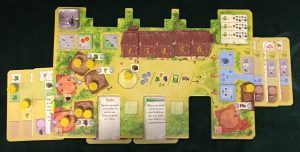
Kez’s Farm
One of the things that attracted Kez to the game was the interesting look of the boards – a central ‘village’ and individual ‘farms’ for each player. Although these look good, and the way the cards work depending on where they are placed means that the layout system is essential to the gameplay, they were a little bit impractical. You place cards under all four sides of your farm, and playing pieces on the board and on the cards, but this means that any accidental knock of the board (which happens frequently as you add new cards underneath) could displace everything. A hazard with any game, I suppose, but as the markers can mean anything from a bottle of wine to a pig depending on where they are on your farm, a little more so in this one. We were even playing on one of the lovely velvet gaming tables from Geeknson, which provides a nice amount of friction (so less opportunity for the boards to slip) than a hard polished table top.
That issue aside, the production quality of the boards, cards and playing pieces is good and the rules were (when read properly…) pretty clear though the booklet could do with slightly better layout in places and a contents or index just for ease of reference. There is also a ‘glossary’ book giving a little more explanation on the cards if needed, but we only referred to it a couple of times (and both times I wondered why the clearer wording in the explanation hadn’t just been used on the cards as they were pretty much the same length).
There are turn sequence reminder cards for each player, absolutely essential as we were still needing it by the end of the game. A reminder of the ‘free’ actions that could be performed at any time would have been helpful too. Not a terrible oversight, but really useful in this sort of game where there are lots of mechanics interacting at any one time and good use of them is part of the strategy.
La Granja is a resource management strategy game with random elements of dice rolls and card pick-ups. You grow crops, produce pigs (as long as you have two in the sty already and room for making more!) and can claim ‘helper’ bonuses and income each round. You use these resources and the potential actions generated in the Revenue phase (odd name, a bit confused with income) to fill barrows to take to market in the village, complete ‘ingredients’ at the craft houses, and repair the roofs on your barns. Victory points are claimed for each of these completed items, along with your progress on the ‘siesta’ track (how hard you’ve worked). The will of the die and cards can change your strategy from round to round, which means it will have good replayability.
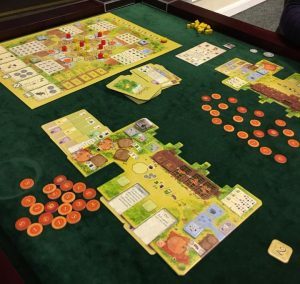
La Granja in play
Kez and I both went for different strategies – I tried to maximise the ‘siesta’ track, and Kez repaired all of her barn roofs, but I don’t think there was one particular strategy that ‘won’ the game – it feels well balanced in that respect. The final score was 69 (me) vs 70 (Kez), so a very close call. We’ll definitely be playing it again.
Here are the official details:
No of Players: 1-4 players
Duration: 90-120 minutes
Age: 12+
Designer: Michael Keller (II), Andreas “ode.” Odendahl
Artist: Harald Lieske
**To make sure you don’t miss out on any blog posts, you can keep up-to-date with everything Gav by signing up to my monthly newsletter. As a bonus, every other month I randomly pick a newsletter subscriber to receive a free signed copy of one of my books.**
Please Feel Free to Share:







October 28, 2016
October 2016 – Q&A
 This is a compilation of questions that have been emailed and messaged to me recently.
This is a compilation of questions that have been emailed and messaged to me recently.
If you want to ask anything, you can post a comment here or get in touch through the contact page (and newsletter subscribers can just reply to any of my emails).
I’ve been posting Q&As for a few months now, so if you’ve found this one interesting, you can look back at previous Q&As here.
Bryan asked on Facebook: A curious question came to mind and thought you might be able to answer. During the Second War of Armageddon Yarrick, Tu’Shan and Calgar conceded overall command to Commander Dante. If Supreme Grand Master Azrael had been at Armageddon, what would have been his reaction? Just curious to know how he would react? I believe he would not let Dante command any Dark Angels.
I don’t think that Dante directly commanded any of the other Chapter warriors – his position as supreme commander was like Eisenhower in WWII – the single point of strategic thought from which the flow of the war was derived, weighing the opinions and plans of the other commanders against each other and political (or in this case Imperial) interest. In that case Calgar and the others are more akin to Monty, Patton and so on, and I believe Azrael would have been content to command under the aegis of Dante as much as the other Chapter Masters present.
This one on Twitter got a little lost in the Warp but I came across it the other day, from Rob: Have you planned how the Dark Angels get from where they are now in the HH to where they are in 40k?
Kinda… I have some ideas, some of which have been discussed with the editorial team and others not. I don’t want to get too far ahead of myself and assume which books I may be writing in the future, and I wouldn’t say it’s a ‘plan’ more of a vague treasure map covering points of interest along the way. However, Legacy of Caliban was written with the assumption that a fair few of these ideas will become reality at some point, whether it’s me writing them or someone else.
Original Brother Artemis Mini
Gavin Thorpe (yes, really!) replied to the newsletter: Firstly I’ll say that my name is Gav Thorpe and I am often confused for you in hobby circles but I’ll be the first to admit I’m not as talented as you but I’m working on it. My question is really surrounding the Deathwatch and has stemmed from your blog post on the background of the Deathwatch. Basically I’m wondering if when a marine is seconded to the Deathwatch would they keep various chapter totems for want of a better word, for example would a Salamanders veteran wear their drake cloak or a Space Wolf don various wolf pelts and talismans etc. I’m looking to build a kill-team and convert the models etc. and want to know how far to go etc.I think that is very likely – as well as the shoulder pad they might well keep such totems and accoutrements. I always liked an old story of the Deathwing that had one suit of Terminator armour loaned by the Ultramarines sill in its original colours because they believed that repainting it offended the machine spirit b- a space marine entering the deathwatch might well feel the same about removing other identifiers of his Chapter of origin.
Hunter contacted me via the website: I’d like to start off with a slight bit of strategic flattery so here it goes. Your work building the lore for the dark angels in 40k and the Horus Heresy has truly been a pleasure to experience. Now that my fandom is out of the way I was wondering if you might have any insight on when the next black library short story submission window might be and perhaps a small clue as to what the desired subject matter might be.
Flattery is always appreciated – writers have such fragile egos!
Unfortunately, in this instance it is also wasted as I have no special insight into the submissions process. I believe that the majority of the last submissions have now passed through the first stage of processing and those that were successful have been passed to the editors. I would expect the next window to be in the first half of 2017 but that’s just a guess, and I have no clues as to the subject.
RedFurioso asked on the website: Hi Gav! Which primarch is best fighter in straight combat, the Lion or Sanguinius? We know the Lion is a supreme swordmaster, but even Horus and Angron feared the wrath of Angel… Hope you like the idea of hypothetical ‘Clash of Angels’!
Sanguinius. He’s my boy. Ain’t nobody could face the Blood Angel in full wrath until Horus got himself all Chaos-infused.
Mike asked on Facebook: Peta Orpheus Epsilon Was that purposely done? Has anyone asked you about that before?
Yes. No.
 Matthew asked on Twitter: You say Inquisitor is in your top three things you are proud of. What are the other two?
Matthew asked on Twitter: You say Inquisitor is in your top three things you are proud of. What are the other two?
In no particular order, Battlefleet Gothic and the last Vampire Counts book I worked on.
For those who follow my music playlist blogs, Joe suggested the following via the website:
13th Warrior by Jerry Goldsmith
Battle Los Angeles by Brian Tyler
Fury by Steven Price
Immortals by Trevor Morris
The Transformers soundtracks by Steve Jablonsky (People like to dismiss the movies but I’ve often found the music the best part about them).
If you want to ask anything, you can post a comment here or get in touch through the contact page (and newsletter subscribers can just reply to any of my emails).
**To make sure you don’t miss out on any blog posts, you can keep up-to-date with everything Gav by signing up to my monthly newsletter. As a bonus, every other month I randomly pick a newsletter subscriber to receive a free signed copy of one of my books.**
Please Feel Free to Share:







October 26, 2016
Hobby Update: Space Marines, Warhammer Quest and Badgers!
 ‘We’ve got a spare blog spot on Wednesday’, Kez informed me (being my organiser, social media manager and general fixer-upper).
‘We’ve got a spare blog spot on Wednesday’, Kez informed me (being my organiser, social media manager and general fixer-upper).
‘Great, we’ll do another Year of Hobby update, with lots of photos.’
All good so far. I then wondered which number update this was and checked on the blog… And apparently 2015 was my year of hobby. My last update for 2016 was back in January, when I shared my hobby goals for the year.
In my defence I have had a lot of books released this year…
Let’s see how I’ve done, shall we? (I don’t expect to emerge from this with shiny hobby credentials, let’s be honest.)
Anyaral – World of Twilight
I’ve been plugging away on my Kickstarter bundle from 2014, and I added some new purchases back in April when I went to the Salute show. There are still more models to be done, but I’ve made some good progress, as you can see below.
And I even managed to squeeze in a game with them when I was at FantasyCon, with the help of fellow author Guy Haley.
So, a solid start actually.
Betrayal at Calth
I said I was going to take a break from Anyaral to tackle the boxed game I bought in December last year. It took a while, but I am pleased to report that there has been movement on that front too. Everything has been undercoated – I’ll be painting the forces for use in the game, so the Word Bearers and Ultramarines legions. Red versus Blue is good to go. Just in time for the new Burning of Prospero to take over as the Horus Heresy game of choice. I can resist that temptation pretty easily at the moment though (and it has reminded me again that I have a complete copy of Space Hulk in the garage that I can paint).
Painted or Not?
I have a simple rule – I don’t play wargames with unpainted miniatures. I like all sorts of games, be they video, role playing, board or card games, and for me the biggest appeal of the miniatures game is, obviously enough, the aesthetic. Painted armies over modelled terrain, that’s what toy soldiers is about.
On the other hand, a playing piece for a board game is just that. It’s a wriggle, I know, to make a distinction between a finely crafted Citadel miniature on a tabletop and a finely crafted Citadel miniature on a board, but it does mean I get to play more games without feeling I have offended the Hobby Gods.
The Ultramarines are going one better than that, and I have painted the Tactical Squad (or Legion Tactical squad if we want to be picky). I’ll be doing the decals for the whole force in one go, and the basing for the whole game needs to be consistent so that will have to wait until both the Ultramarines and Word Bearers are ready.
So, two for two at this stage (if I squint and tilt my head).
With that in mind I have almost finished assembling my Warhammer Quest: Silver Tower set. I had a demo of the game during a store signing in Derby and really enjoyed it, so I’m looking forward to getting the last of the denizens assembled read to play.
Burrows and Badgers
These have been sitting on the ‘to paint’ pile for quite some time but I have started putting paint on them at long last. As they are all individual miniatures I’m doing them in very small batches of a few models at a time, to allow me to focus on the colours for each miniature.
Not sure four half-painted models really count, but they are started. Two-and-a-half out of three?
Vehicles and Filbots and Voodooworx
My models from the Road/Kill Kickstarter still languish in their boxes, for shame, but I can claim another partial win for getting a lick of paint on one of my Filbots. Along with some models for Open Combat I’ve been practising my highlighting and blending on this one, as primarily my painting of the last couple of years has been far more predicated on ink washes and drybrushing. However I have a number of very nice new arrivals and pending arrivals (including Human Interface: Nakamura Tower, Bombshell Miniatures’ Kritterkins, Rumbleslam, Mythos and Parallax: Warbands*) that definitely need a more refined approached to painting, as well as the Warhammer Quest miniatures.
I’ve been trying out something else for my Voodooworx Hul’Gren model, using mostly ink washes to get the colours. If it looks okay when I’ve finished I’ll try the same on the other models – and if you want to read more I have a number of short stories set in the world of Tir-Dagrau available from Fogberry Press.
*Kickstarter
I don’t think I need to go into any more detail regarding how well I’m doing on my vow to back fewer Kickstarters… In fact, Kickstarter have really rammed home my failure by making me a ‘superbacker’. Oh well, I can live with that.
Other Games
While the regular gaming hasn’t quite happened every other week as I envisaged, we have managed to get together semi-regularly for games of Cthulhu Wars, Scythe and Gorechosen (yes, another GW boxed game with models to paint. Did I not mention that one earlier?).
Kez and I also continue to sneak in the odd morning or day (when babysitters allow) at The Dice Cup games café, and we’ve been introduced to a few new games by the team there. These include Evolution, Imhotep and Hey, That’s My Fish! among others. Our hope for the future is to get in a whole game of Sid Meier’s Civilisation that we bought a copy of, but haven’t succeeded in starting that yet.
ROBIN
My next hobby goal, as I mentioned in my last newsletter, is to run a demonstration or participation game at the ROBIN wargames event in Nottingham next February. As of the time of writing I have pinned my efforts to a mech fighting game. Probably 6mm scale, but not attached to any particular miniatures range.
All I need now are models, a table, some terrain, cards and special dice, and to create the rules… What could go wrong?
**To make sure you don’t miss out on any blog posts, you can keep up-to-date with everything Gav by signing up to my monthly newsletter. As a bonus, every other month I randomly pick a newsletter subscriber to receive a free signed copy of one of my books.**
Please Feel Free to Share:







October 22, 2016
The Publishing Journey
 I’ve had a warm and fuzzy feeling these last few months, not because I drink too much coffee, but because I’ve received messages from several people who have got through the first and second stages of the Black Library open submissions window, thanking me for the writing advice I’ve given. What started as a way for me to formalise my thoughts on various aspects of writing, is now a large resource – nearly 100 posts in total – that is actually helping people get one step closer to being published.
I’ve had a warm and fuzzy feeling these last few months, not because I drink too much coffee, but because I’ve received messages from several people who have got through the first and second stages of the Black Library open submissions window, thanking me for the writing advice I’ve given. What started as a way for me to formalise my thoughts on various aspects of writing, is now a large resource – nearly 100 posts in total – that is actually helping people get one step closer to being published.
As these people go through the commissioning process for the first time, I thought it might be useful to go through the different stages of working with a publisher. I’ll caveat this to say I’ve generalised a little bit as all publishers are different, but the steps below should give you a typical outline of the process.
Stage 1 – Pitch to Synopsis
You’ve pitched your story idea and the editor has asked you to provide them with a synopsis. Congratulations! Now listen carefully. Not to me, to the editor. If they ask for a word count, or two sides of A4, stick to it. If they ask for a principal character list with short bio, give it to them. At this stage, nothing has been commissioned, so you’re still trying to impress them, and they need to know you can follow instructions and will treat their requirements for your novel with equal care. At this stage there may be some back and forth as they help you to think through and re-structure your story as necessary.
This is more in the model of the Black Library, who will commission on an agreed story rather than have a ‘slush pile’ of prepared manuscripts they work through. For other publishers you may be submitting an entire novel or short story to an agent or editor, but it is still worthwhile having a pitch and a synopsis as well, in case you come across a submissions process that doesn’t ask for a completed manuscript.
Stage 2 – Commission
They love your synopsis and want to commission your story! A common payment structure for a novel is 1) payment on commission, 2) payment on submission of midway manuscript, and 3) payment on acceptance of final manuscript. Many publishers offer a multi-book deal, and will contract for two or three books in one go – these days quite often it will be for two books with first refusal to commission a third if they sell well enough. The first advance payment may well be for all of the books together (as it was when I write The Crown of the Blood) which is a nice chunk of money but don’t forget you won’t be getting those first payments further down the line!
Short stories are usually paid by the word; the contract or commission will specify the actual ‘length’ for which you will receive payment, it doesn’t usually mean you will literally get twenty pence less if you write 3,996 words instead of 4,000. This will be on acceptance of publication. Black Library are generous in that they also pay commission on sales of digital audios and ebooks based on short stories, on top of the flat rate already paid. When you have an extensive catalogue of short fiction and audios as I do that adds up nicely every six months.
Don’t crack open the champagne just yet – you still have to put pen to paper (or fingers to keyboard).
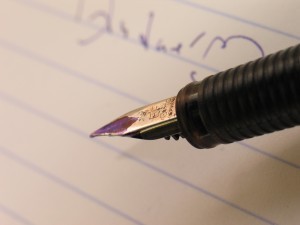 Stage 3 – Write the Book
Stage 3 – Write the Book
How difficult can it be? Whilst you can happily / unhappily get bogged down in the detail of exactly how the magic system works, or what happened in your protagonist’s early years to make them the psychopath they are today, your editor can see the story through the prose. If you find yourself really struggling (I don’t like the term ‘writer’s block’), talk it through with them and use their knowledge and experience to help you over any hurdles. Don’t worry about looking like a fraud, they already know it’s your first story, and they liked your synopsis enough to commission you, but they can’t help if they don’t know there’s a problem.
The editor will want to receive your manuscript on time, so if you think you’re going to miss the deadline, let them know ASAP. Sometimes life can get in the way, it happens, but give your editor as much notice as you can and they might be able to re-schedule their other work around the revised timetable.
Stage 4 – Desk Edit
You’ve delivered your manuscript, and now it’s sat with the editor. Nope, still not time to open the champagne. The first round of edits will look at the story itself. Need to flesh out the background of this character? Too much description of that city? Chapter twelve works better later in the book? All this will come back to you, probably in the form of comments within your manuscript. Don’t feel nervous about disagreeing with an editors comment – you might just need to explain your thinking, and make something clearer in the story. Equally, your editor will probably have years of experience, so make sure you listen and learn from their feedback.
It is also a good idea to make a hard copy of the manuscript itself (often shortened to ‘mss’ in editor parlance) to read through and apply the red pen. Some people advocate reading your story out loud to help with the flow of the words. I don’t transfer these corrections into the mss until I also have the editorial feedback – some may be duplicated, some might be changed or take out entirely. Try to work with a as few drafts as possible, so that you only have one version at a time that both you and the editors are looking at. It’s important that you work on the correct documents, to ensure consistent version management and editorial continuity.
Stage 5 – Copy Edit
You’ve gone through the edits, and you and the editor are both happy with the content. At this point the revised manuscript will be sent to a copy editor who will look at spelling, grammar, punctuation, continuity and consistency etc. Depending on the publisher, you may also get sent the manuscript at this point, and there will still be time to make any vitally important changes.
Stage 6 – TypE se t ting
The flesh and bones are agreed, and now it’s time for typesetting. This literally sets out how the words will appear on the page – paragraph and letter spacing, page breaks, and the general readability of the text. Again, you may also get to see the manuscript at this point, although it’s probably too late to make any changes unless they are absolutely required.
For a novel you may be asked for any dedications, acknowledgements and ‘thanks to’ at this stage, sometimes a stage earlier.
 Stage 7 – Sit Back And Wait!
Stage 7 – Sit Back And Wait!
The excitement of finishing your book may be a distant memory by the time your book hits the shelves. The longest I’ve had to wait between submitting a project and publication is about 2.5 years, although anywhere between 6-18 months is the norm. While the project is fresh in your mind, put together a plan to market your story or book. Hopefully your publisher will market and advertise your book, but if you’re planning on a career in writing, you’ll need to do this too.
Stage 8 – Publication
You will probably receive sample copies of your anthology or novel a month or so before release, and can fondle it while you sit back with the satisfaction that you have accomplished something that many dream about. Congratulations – now you can open the champagne! Hopefully you will be busy with interviews, book signings, conventions, and of course… writing your next book.
Stage 9 – Royalties / Commission Payments
Publishers have varying timetables for paying royalties, as laid out in the contracts but every six months seems to be the norm. For example Black Library royalties run January-June and July-December, with actual payment received two-or-three months later.
Well that’s a whistle-stop tour of the publishing journey – I hope you’ve found it useful. You can read all my writing advice blog posts here. As always, if you have a specific question, or a topic you’d like me to cover, leave a comment below.
**To make sure you don’t miss out on any blog posts, you can keep up-to-date with everything Gav by signing up to my monthly newsletter. As a bonus, every other month I randomly pick a newsletter subscriber to receive a free signed copy of one of my books.**
Please Feel Free to Share:







October 19, 2016
A Brief History of the Deathwatch
Original Brother Artemis Mini
Or, how I made up a thing 16 years ago and now amazingly it’s currently the hottest trend in 40K.There’s a lot of talk about the Deathwatch at the moment in the Warhammer 40,000 community, with the recent releases of two boxed games and an army, as well as accompanying short stories and novels. It’s not often that I spend time contemplating the contributions I’ve made to Warhammer and 40K over the years, but the scale of the evolution and elevation of the Deathwatch has prompted me to reflect on their pragmatic beginnings.
We Need A Big Space Marine
Back in the heady days of 1999 I was working on Inquisitor – Battle for the Emperor’s Soul. In the early stages of development I sat down and started working on a proposal for the miniatures ranges that would be attached to the game. The range would be relatively small at just 15 codes, and because of that the characters we chose would have to represent not only strong archetypes and images but also be flexible in their application, capable of serving alongside each other in different types of warrior bands.
It was decided from the outset that there would be a space marine included. The main thrust of Inquisitor was to present a range of 54mm miniatures for modellers and painters and it would be lunacy not to include one of Warhammer 40,000’s flagship warriors. Given the level of detail on the model it would be better if we did not single out one Chapter to represent but gave collectors the option of painting a warrior from any Chapter.
On the other hand, the background for the game and rules were clearly moving toward a more covert, roleplay-centric approach. Not ideal ground for power armoured holy warriors intended to rampage across the bloody battlefields of the galaxy.
 It was also obvious that a space marine would be of a power level equal to if not greater than a typical Inquisitor in game terms (or a Chaos Magus, as was also initially envisaged, though that’s a whole other post…) and therefore the space marine character would also have to be someone that could potentially substitute as a leader of a warrior band to keep the power level of the game from escalating.
It was also obvious that a space marine would be of a power level equal to if not greater than a typical Inquisitor in game terms (or a Chaos Magus, as was also initially envisaged, though that’s a whole other post…) and therefore the space marine character would also have to be someone that could potentially substitute as a leader of a warrior band to keep the power level of the game from escalating.
So that became the brief – a space marine that could equally lead an Inquisitorial warband, or operate alongside an Inquisitor, of no particular Chapter.
Aside – back in my days on White Dwarf I had a similar task with Ian Pickstock, to come up with a promotional non-Chapter space marine character, I think for the Apocalypse 100 retail event (although that might have been when we created Centurius, it all blurs). From that simple brief came the Emperor’s Champion, the legend of Sigismund and all else that has followed! From small acorns and all that.
The Alien Hunters
It so happened that roughly at the same time, work had begun on what would become Codex: Armageddon, detailing the battles and forces of the Third Armageddon War. As part of the book I concocted a list of participating forces – names of Chapters, Titan Legions, Imperial Guard regiments. I threw in a few exotic references, including, if I remember correctly, ‘Six Ordo Xenos kill-teams’.
The alien hunters of the Ordo Xenos persuasion had long been under-represented in 40K. The Realm of Chaos books and Grey Knights had fleshed out a lot of the daemon-hunting Ordo Malleus, and some of the work I did on Sisters of Battle and later developments intended for Codex: Witch Hunters added meat to the bones of the Ordo Hereticus.
There seemed a gap wanting to be filled…
New Brother Artemis Mini
Arise, Captain of the DeathwatchMy original idea for the Deathwatch was to portray something different to the Grey Knights (a Chamber Militant of the Inquisition) and the Sisters of Battle (a convenient affiliation). My concept was not for a single organisation like a Space Marine Chapter but a series of historical arrangements between many space marine Chapters and agents of the Ordo Xenos, codified but not rationalised.
I wish I still had my original notes but they have been lost to antiquity, but they went along the lines of:
Who guards the Gates of Varl against the quiescent perils of the C’tan? Who stands ready to combat the menace of the Behemoth and the Kraken? Who patrols the endless night of the Halo Stars?
The Deathwatch!
A single brother of the Deathwatch could be dispatched on a particular mission, calling upon those ancient agreements. He might spend years or decades on that duty until relieved or killed, perhaps never heard from again. Or he might be sent into the depths of a hive world to root out a genestealer cult (the enemy within de jour) or to cleanse a hrud infestation. Over the course of that duty the Deathwatch warrior might, like an Inquisitor, accumulate necessary companions…
Jes Goodwin created the first Deathwatch warrior, of which he has spoken about in the pages of White Dwarf and art books. For my part, the job then became turning the concept into a character. Every miniature in the Inquisitor range is an individual, and while they might be used to represent a wider type, each had their own name and backstory.
With Brother-Captain Artemis I wanted to demonstrate that the space marines of the Deathwatch are chosen not just for their lethality, that they are more than just a space marine with specialist equipment. The warriors of the Deathwatch are possessed of a desire to understand their enemies, the better to slay them. Like the Inquisition they must be ready to embrace the unexpected and unorthodox, with initiative and flexibility rather than dogma and doctrine.
It is these traits that best distinguish the Deathwatch from a space marine chapter – they adhere to no ‘cult’ other than that which they bring with them from their Chapter, but the Ordo Xenos provides a unique, sometimes pro-active modus operandi. Tasked to a singular mission, the Deathwatch can put aside all other considerations of duty until the enemy is slain, the threat contained.
A lot of the Deathwatch background was expanded in the roleplay game of the same name by Fantasy Flight, until we come up to the present day and the recent releases from Games Workshop, fleshing out the ideas into a full army (which, if I’m honest, I am in two minds about, given the original concept as an organisation of small teams and solitary warriors).
The first appearance of a Deathwatch Space Marine in Black Library fiction is older than many people realise – being in my appropriately named Last Chancers novel, Kill Team. I then returned to them, and Brother-Captain Artemis in particular, with the audio drama Mission: Purge and the short story Mission: Annihilate
In the last year and more, a number of short stories and novellas have entered the world, with the most prominent recent additions to the Black Library lore of the Deathwatch coming from the likes of Robbie MacNiven, and Ian St Martin – who was nice enough to ask me for a bit more detail on the warriors featured in the Mission: X stories for a forthcoming work. I shared my character bios with him, and it seems fitting that I share them with you now…
(Not all of them ended up like this in the story, but you get the idea about the range of characters the Deathwatch can provide.)
Brother-captain Artemis Mortifactors Chapter. A warrior that personifies the Imperial adage ‘Only in death does duty end.’ Absolutely will not give up until the genestealers have been eradicated and never once gives thought to defeat. A veteran of many campaigns, he considers it an honour to be serving in the Deathwatch.
Haryk Thunderfang: Space Wolves Chapter. A pragmatic warrior, Haryk is adaptable and steadfast, adjusting to the ever-changing situation with calm aplomb. He is vocal with his opinions but wholeheartedly backs whatever plan is agreed when the decision has been made. He serves with the Deathwatch as a matter of fulfilling the Chapter’s oath and considers it his duty even if he would rather be with his Great Company.
Brother Neremis: Red Talons Chapter. Taciturn to the point of anti-social, Neremis is a reluctant member of the kill team, having been chosen by lot to represent his Chapter’s obligation. He is the most technically-minded of the squad, acting as armourer, his skills outweighing his truculent nature.
Brother Urbino: A Black Shield. As a Black Shield, Urbino’s origins are kept secret. He has severed ties with his former Chapter and serves only the Deathwatch now. [[If you want to know more about Brother Urbino, and have listened to Mission: Purge, click through here to my spoilers page. Everyone else, be warned – spoilers!]]
Brother Lavestus: White Consuls Chapter. The born-again space marine, devoted to the Emperor as a god. Basically, what if one of the guys in the team was an evangelical Christian and kept trying to convince his mates to join him? That’s this dude. A deadly, righteous warrior who feels that being sent to the Deathwatch is somehow an opportunity to be a missionary for his Chapter’s beliefs.
Brother Sekor: Imperial Castellans Chapter. Young and head-strong, Sekor is not long out of his Chapter’s Scout company and has been dispatched to the Deathwatch for some undisclosed misdemeanour. Seeing his term with the alien hunters as a punishment, and only temporary, Sekor borders on insubordinate, claiming that Artemis and the others have no true authority over him. This will get him killed. Oh well.
If you’re interested in reading more about my involvement with Inquisitor, head over to my Games Page.
**To make sure you don’t miss out on any blog posts, you can keep up-to-date with everything Gav by signing up to my monthly newsletter. As a bonus, every other month I randomly pick a newsletter subscriber to receive a free signed copy of one of my books. The next competition is for a copy of my Horus Heresy Audio, The Thirteenth Wolf.**
Please Feel Free to Share:







October 15, 2016
Red On Blue In Nottingham
As I’ve mentioned in a couple of my previous newsletters, there is going to be a new wargaming event in Nottingham next year, called ROBIN – Red On Blue In Nottingham.
As well as myself, there will also be seminars and demos from fellow former Games Workshoppers Rick Priestley, Alessio Cavatore, John Stallard, and Michael & Alan Perry. I’ve also taken the plunge and committed to run a demo game at the event, although at this stage I’m not sure which of the many games I’ve been working on will actually be ready to take – you can read more about my dilemma below.
In case you’re not signed up for my newsletter, here’s a bit from my last e-mail about my preparations (or thoughts, at least) about what I’ll be doing at the ROBIN event.
Early next year is a new event, ROBIN, being run in Nottingham. I’ve been asked to do a panel, seminar thing, which all sounds great fun. On top of that, I took a bit of a leap and asked for some space to run a demo game. Now that was a few months ago and it’s reaching the point that I need to decide exactly what game I’m going to put on…
It doesn’t have to be a game of my own design. It is, after all, perfectly allowable to run demonstrations and participation games of existing rulesets. I could theme something for Open Combat, for example, or maybe make a nice board for Anyaral: The World of Twilight.
But that does seem a bit of a wasted opportunity. I’ve been tinkering around with various rules designs for several years now – well seriously for about five years for some of them. Giving myself a bit of a deadline to have something workable would be a nice stepping stone. It would also be a great chance to put an idea out there, in front of actual gamers who aren’t me. I think I’ve got some neat ideas, but are they the sort of game that will gain a following if I was to publish them?
I don’t need to have a full rulebook ready to go, just enough to put some miniatures on a table and run a few games. Some of my rules are in that state already, some aren’t. And like many gamers my attention span is fly-like in duration so that what I want to work on changes pretty much on a weekly basis.
At the moment I have a set of World War Two rules that are, aside from actually playing some more games, good to go. While the beauty of the system I am designing is about giving players the choice to field whatever they want from their collections, and a scenario generation system tailored to pick-up play, the gameplay could easily be showcased on a demo event too. This is my default position.
I have some rough Old West gunfight rules based on poker that are quickplay, which might be fun to turn out. On the downside, I have the figures but not painted, and absolutely no terrain yet… Good convention fodder, I’m sure, but more work than the WWII game.
And then I come round to my game of the moment, a hankering for some 15mm massed mech combat. This is perhaps the game closest to my likes and interests, and hence something of a work of passion. The reality is though, aside from a few vague thoughts, I have nothing written, no miniatures painted (and probably not enough unpainted for what I have in mind), and no table to play on. This could be the spur to get me going, or a massive rod for my own back.
And of course, by this time next week I might have changed my mind again…
So get the date in your diary, and I’ll see you there, and maybe let me know in the comments which of those games tickles your interest.
**To make sure you don’t miss out on any blog posts, you can keep up-to-date with everything Gav by signing up to my monthly newsletter. As a bonus, every other month I randomly pick a newsletter subscriber to receive a free signed copy of one of my books.**
Please Feel Free to Share:







October 12, 2016
Nipple-Toothed Space Marines?
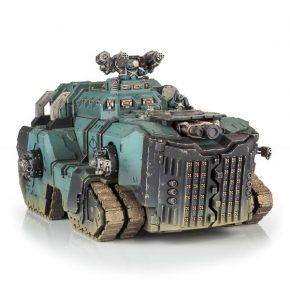 As I’ve mentioned before in posts and interviews, when Forge World started producing books and miniatures for the Horus Heresy, it ignited something of a creative surge in my treatment of the war gear and vehicles of the Space Marine legions. It showed that as authors we could push the concept of what warfare with the Legiones Astartes might encompass, pushing the imagery and concepts into new areas.
As I’ve mentioned before in posts and interviews, when Forge World started producing books and miniatures for the Horus Heresy, it ignited something of a creative surge in my treatment of the war gear and vehicles of the Space Marine legions. It showed that as authors we could push the concept of what warfare with the Legiones Astartes might encompass, pushing the imagery and concepts into new areas.
My first opportunity to exercise that new-found spark was in my Primarchs novella, The Lion. During the course of that story, we encounter a force of Iron Hands embattled against the Grave Wardens of Calas Typhon from the Death Guard Legion.
In one particular scene the Iron Hands are launching an assault against the Death Guard positions. It occurred to me that the Space Marines would have something bigger and more powerful than the Rhinos and Land Raiders we have come to know so well from the Chapters of the 41st millennium. Something much bigger…
I’ve always been inspired by a specific image from the early days of my hobby involvement. Appearing in UK White Dwarf issue 130 it depicts hundreds, if not thousands of Space Marines disembarking from several Capitol Imperialis transports. I’ve dug out my copy to share with you… (That was a trip into some serious nostalgia, but I’ll save that for another post.) As you can see, this is the essence of the Horus Heresy, Space Marine Legions deployed like Imperial Guard regiments are in 40K.
The scene for The Lion and the numbers involved didn’t justify the presence of a Legiones Astartes Capitol Imperialis, but it did beg the question of what the Space Marines might use that was somewhere between the squad-carrying Land Raider and the company-carrying Behemoths.
My answer was the Mastodon, a super-heavy Legiones Astartes transport. It was a bit of a throwaway reference at the time, included to evoke the idea that the Legions have far larger armouries than we could imagine, hinting at technologies and machines unseen.
“The Iron Hands sallied forth from the main gateway of Tower Two, Predator battle tanks and Land Raider Armoured Carrier spearheading the thrust, while the force’s Rhinos and the larger Mastodon transports followed behind the more heavily armoured screen.”
“The slower, bulkier Mastodons, each quadruple-tracked and towering above the Land Raiders, powered through the dust and fog as quickly as they could, their heavy tracks carving fresh ruts in the baked surface of Peritus Ultima.”
“A further eight Mastodons followed behind, each carrying forty Iron hands warriors, their power fields soaking up autocannon shells and lascannon blasts with actinic flashes of energy.”
Imagine my delight a few years later, to find that the fine designers and writers at Forge World have taken that creation and turned it into a tabletop reality. You can see it in all its glory in this video.
“The Mastodon was one of the heaviest assault transports in the arsenal of the Legiones Astartes during the Great Crusade, and is still found in the armouries of the Space Marine Chapters of the 41st Millennium. Its cavernous assault bay, capable of housing almost half a Company, is protected both by thick layers of ceramite armour as well as crackling void shields. It also mounts a fearsome siege melta array, allowing it to breach even the most formidable defences with ease, as well as an array of secondary weaponry intended to defend the vehicle as it approaches its target. Unleashed only against the most fearsome of enemy redoubts, there are few obstacles that can stay the wrath of this relic of the Imperium’s bloody birth.
The Mastodon is heavily armed and armoured, carrying 40 Space Marines, and even Dreadnoughts, safely to the heart of battle. Whilst embarked, the warriors within will defend their immense transport, turning the sponson weapons on any enemy brave or foolish enough to come close. It’s Siege melta array can easily destroy fortifications, and makes short work of armoured vehicles, whilst its Skyreaper Battery will tear through any airborne threat with ease.”
You can also watch a great review of the new model from Sup3rSaiy3n on YouTube.
And to explain the title of this blog post – did you know “the name mastodon comes from the Greek μαστός and οδούς, meaning “nipple tooth,” reflecting the distinctive, nipple-like protrusions on the crowns, which would have been more conducive to browsing on trees, shrubs, and swamp plants than grazing on grasses, as with the mammoths and their flatter, ridged teeth (Dykens and Gillette, BBC 2008)”
What do you think of the Mastodon – will you be buying it?
**To make sure you don’t miss out on any blog posts, you can keep up-to-date with everything Gav by signing up to my monthly newsletter. As a bonus, every other month I randomly pick a newsletter subscriber to receive a free signed copy of one of my books.**
Please Feel Free to Share:







October 9, 2016
Corax Painted Mini
If you’ve been following my blog this week, you can’t fail to have noticed that my new Horus Heresy anthology, Corax, was released this week. To round-off my shameless promotion in the best way possible, here are some pictures of a painted Corax mini, that were sent to me by Christopher Burch. Christopher is now working full time with the painting team at Frontline Gaming.
And just in case you haven’t been paying attention to my blog this week, you may have missed:
My Author’s Notes on ending Corax’s journey in the new novella Weregeld
An extract from Weregeld
The music playlist I used to write Weregeld
The Corax story so far (previously published on the Black Library website)
And as an added bonus, here’s a link to Neil Roberts’ brilliant artwork for Corax as wallpaper.
**To make sure you don’t miss out on any blog posts, you can keep up-to-date with everything Gav by signing up to my monthly newsletter. As a bonus, every other month I randomly pick a newsletter subscriber to receive a free signed copy of one of my books.**
Please Feel Free to Share:








